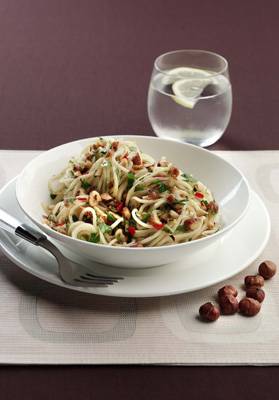Hazelnut, chilli and garlic pasta

Hazelnut, chilli and garlic pasta
Unhealthy saturated fats vs healthy unsaturated fats - can you spot the difference?According to Nuts for Life Consumer Research on Australian adults in 2008, many people are confused about dietary fats - what's healthy and what's unhealthy. While nearly three quarters of those surveyed (74 per cent) correctly understand that saturated fat is the unhealthy or 'bad' fat, most people are confused about the difference between the unsaturated fats - the monounsaturated and polyunsaturated fats.
So, what is the difference? And how can understanding the fats in your diet help you to shed those post-Christmas kilos and ensure better overall health in 2009?
Each type of fat is never found solely on its own in food sources. All three are usually present but in different proportions.
Saturated Fat:
Mainly found in food from animal origin meat and dairy. An exception includes products made from plant based coconut and palm oil. The liver in our body can make blood cholesterol from the saturated fat we eat in our diet. High blood cholesterol is linked with an increased risk of heart disease.
Polyunsaturated (poly) Fat:
Derived mainly from plants nuts, seeds, plus fish and seafood. Polys can be further classified as omega-3 and omega-6 fatty acids. Polys are needed for cholesterol lowering and heart health. Marine omega-3 fats are also needed for healthy brain function and for maintaining healthy joints. Walnuts, hazelnuts, pine nuts and brazil nuts are high in polyunsaturated fat.
Monounsaturated (mono) Fat:
Also mainly derived from plant-based foods nuts, avocados, olives, canola and nut oils and eggs. Monos regulate blood cholesterol levels but not to the extent that polyunsaturated fats can. They can however raise HDL cholesterol- the 'good' kind that helps clear arteries. Macadamias, cashews, almonds, pistachios and pecans are high in monounsaturated fat.
Are nuts a source of healthy or unhealthy fat?
While tree nuts contain between 49 - 76 percent fat, with the exception of chestnuts which contain 0.5 percent, this does not mean they are unhealthy.
-The majority of fat comes from "good" fats - poly and mono, which help lower blood cholesterol levels and are good for your heart.
-Nuts are packed with vitamins, minerals and antioxidants, but most importantly for weight watchers they are also a source of dietary fibre and protein - two factors that are known to prolong feelings of fullness, thus helping to lower food consumption.
-To help manage your weight, substitute foods like biscuits, cakes, pastries and fried snack foods with fruit and nuts. Eating a variety of nuts will help provide the right balance of healthy fats in your daily eating plan.
Nutrition research has shown that eating just a handful of nuts (30g) most days can reduce the risk of heart disease, improve blood circulation and lower the body's blood cholesterol. In addition they help control hunger cravings. These delicious, crunchy foods are a great way to get healthy and stick to those New Year resolutions!
Ingredients
400g spaghetti pasta
1p tablespoons olive oil
100g chopped hazelnuts
1 long red chilli, seeded and finely chopped
2 cloves garlic, thinly sliced
1/3 cup chopped flat leaf parsley
2 teaspoons lemon juice
salt and cracked black pepper
Method
1.Cook the spaghetti in a large saucepan of boiling water until al dente. Drain, return to pan and keep warm. Heat the oil in a non stick pan over medium heat.
2.Add the hazelnuts, chilli and garlic and cook for 3-4 minutes, stirring regularly.
3.Remove from heat, stir through parsley, lemon juice and season with salt and pepper to taste. Toss the hazelnut mixture through the pasta and serve.
Serves 4.
MORE





